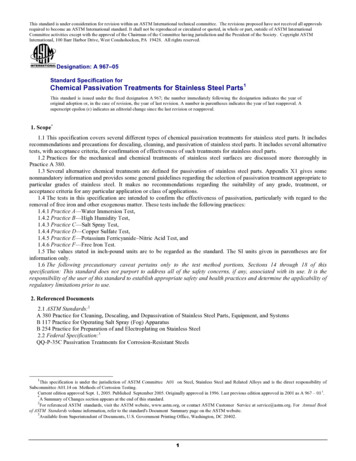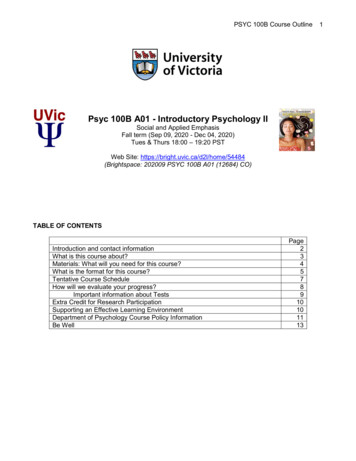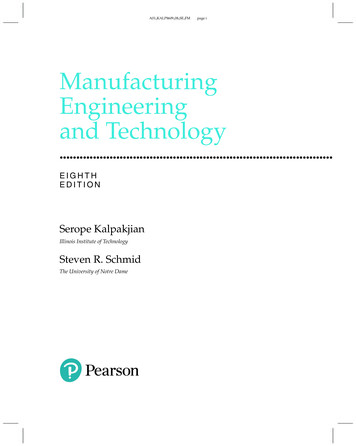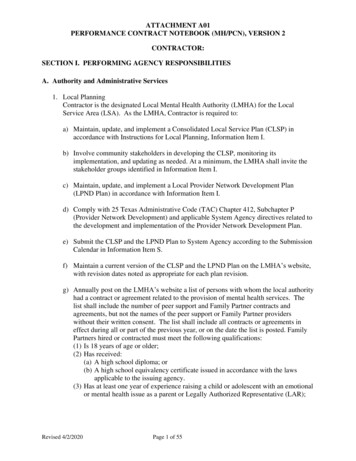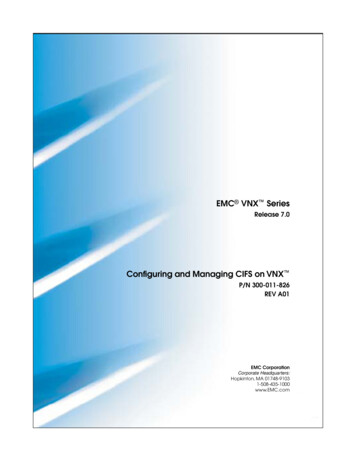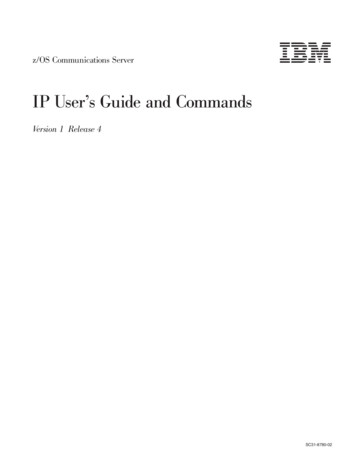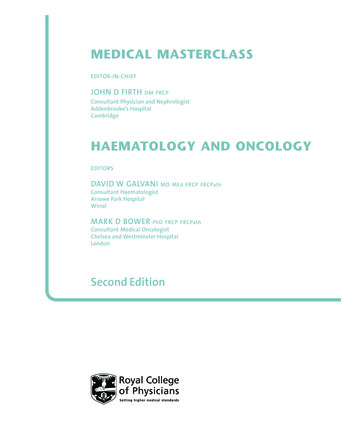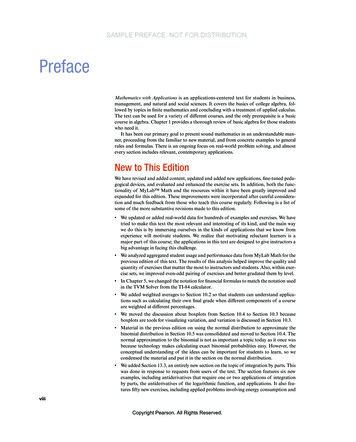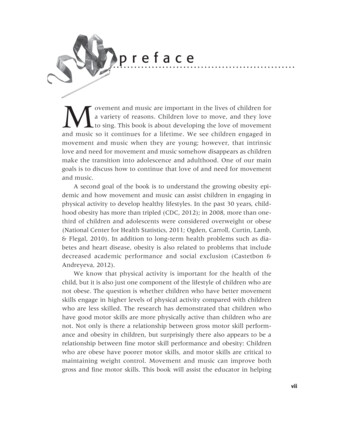
Transcription
A01 GALL5688 01 SE FM.indd Page vii 2/13/14 12:11 PM ALLAGHER:PH01414prefaceMovement and music are important in the lives of children fora variety of reasons. Children love to move, and they loveto sing. This book is about developing the love of movementand music so it continues for a lifetime. We see children engaged inmovement and music when they are young; however, that intrinsiclove and need for movement and music somehow disappears as childrenmake the transition into adolescence and adulthood. One of our maingoals is to discuss how to continue that love of and need for movementand music.A second goal of the book is to understand the growing obesity epidemic and how movement and music can assist children in engaging inphysical activity to develop healthy lifestyles. In the past 30 years, childhood obesity has more than tripled (CDC, 2012); in 2008, more than onethird of children and adolescents were considered overweight or obese(National Center for Health Statistics, 2011; Ogden, Carroll, Curtin, Lamb,& Flegal, 2010). In addition to long-term health problems such as diabetes and heart disease, obesity is also related to problems that includedecreased academic performance and social exclusion (Castetbon &Andreyeva, 2012).We know that physical activity is important for the health of thechild, but it is also just one component of the lifestyle of children who arenot obese. The question is whether children who have better movementskills engage in higher levels of physical activity compared with childrenwho are less skilled. The research has demonstrated that children whohave good motor skills are more physically active than children who arenot. Not only is there a relationship between gross motor skill performance and obesity in children, but surprisingly there also appears to be arelationship between fine motor skill performance and obesity: Childrenwho are obese have poorer motor skills, and motor skills are critical tomaintaining weight control. Movement and music can improve bothgross and fine motor skills. This book will assist the educator in helpingvii
A01 GALL5688 01 SE FM.indd Page viii 2/13/14 12:11 PM 14/GALLAGHER:PH01414Prefacethe children develop the concepts and skills to successfully participate inphysical activity. In “M2 Fun” segments throughout the book, we giveexamples of ways to get children engaged in movement and music.Both movement and music enhance academic performance in mostcases, but they have never caused a detriment in academic performance,even when including movement and music in the curriculum reducedthe time spent in academic learning. We discuss the research on the relationships among physical activity, music, and academic performance andaddress the factors that affect brain development. Physical activity andmusic provide children with a release of energy and assist focusing on thecontent of their academic studies. We provide a variety of examples ofhow to integrate both movement and music into the day to reduce behavioral problems and increase attention to academic performance.Movement and music are important in the learning and developmental processes of infants, toddlers, and young children. This book strives topresent this information to future educators so they can understand thebenefits of movement and music and learn how to motivate and engagechildren in movement and music. We are not only preparing the educator to teach young children today, but we also have to teach the child theskills that will be needed in 2025. Today we do not know the exact skillsthat will be required to live in 2025; therefore, we must be able to providechildren with the abilities and skills they will need to adjust to and makedecisions in the world of the future.Guiding Principles of the BookThe book is founded on the following guiding principles based on theNational Association for the Education of Young Children’s (NAEYC’s)framework of Developmentally Appropriate Practices:1 Individual Needs Met2 Environment and Curriculum Reciprocated3 Movement and Music Integrated4 Family and Community Involved5 Standards and Assessment Provide Guidance
A01 GALL5688 01 SE FM.indd Page ix 2/13/14 12:11 PM ALLAGHER:PH01414PrefaceThe child is at the center of education and learning. We need to understand the child at his or her own level and match the environment and curriculum to the child’s level. Movement and music are integrated throughoutthe curriculum to bring joy to the child and assist in engaging the child inthe curriculum. Family and community are part of the learning process andneed to be involved in schooling. Standards are required to determine thedevelopmentally appropriate curriculum, and assessment assists in modifying the curriculum to determine the next level of performance. Each chapteris built on a combination of these five guiding principles—and the final chapter assists the learner in evaluating the application of the guiding principles.Application of Movement and MusicAn important component of the book is application. We provide examples of application of the knowledge, concepts and skills throughout eachchapter. We start each chapter with Chapter Learning Outcomes andGuiding Principles, followed by Making Connections. The learningoutcomes are objectives that we have linked to guiding principles. Eachof these learning outcomes navigates the student to the main headingsthroughout the body of the text. Following the learning outcomes, wepresent a true scenario that demonstrates the main concepts of the chapter.Interspersed throughout the chapter are Movement and Music Fun2(M Fun) suggestions. These assist the reader in having fun with childrenwhile engaging in movement and music learning. Also woven throughthe chapters in the Pearson eText are hyperlinked videos illustrating keyconcepts and applications to enhance the course content.We conclude the chapter with a general chapter summary, but wealso include a summary for each learning outcome. To assist students inapplying the information, we give them the chance to practice the concepts in the Demonstrate Your Knowledge, Skills, and Dispositionssection. These assignments can be done for classwork or homework.To conclude each chapter, we present a section titled Planning forEngaging. This provides the student with a simple example of teachingto a standard. We select an M2 movement, music, or dance standard anddevelop three learning activities that can be used to develop the contentstandard. An example of an evaluation for each of the learning possibilitiesix
A01 GALL5688 01 SE FM.indd Page x 2/13/14 12:11 PM GALLAGHER:PH01414Prefaceis included. A second Planning for Engaging example is provided, calledNow You Try It; however, in this case, only the first learning possibilityis provided. Following the first example, the children can develop two oftheir own learning possibilities.Instructor ResourcesAn instructor’s resource manual provides additional ideas for the teachereducator in engaging the student in the content. We begin with a suggested course outline for a 15-week class that meets two days per week.For each class session, we provide suggested class activities and “new tothe text” ideas for class breaks. Additional explanations and class assignments are included. A test bank includes test questions. PowerPoint Slidesare also available.Chapter SummariesChapter 1: Movement and Music Working Togetherto Create a Healthy ChildIn this chapter, we focus first on understanding the importance of movement and music in the lives of young children. Movement and music arepart of an individual’s life prenatally and remain so throughout life, intoold age. Information gathered from the various sensory systems enhanceslearning, whereas movement and music are used to express emotions. Thechild’s environment influences his or her engagement in movement andmusic—either encouraging or discouraging it. Children initially engagein movement and music through exposure, followed by instructionalengagement and, finally, mastery. Howard Gardner’s multiple intelligencetheory is examined and related to movement and music. The concept ofdevelopmentally appropriate practice is emphasized. Theories advancedby John Dewey, Jean Piaget, Lev Vygotsky, Urie Bronfenbrenner, KarlNewell, and Émile Jaques-Dalcroze are discussed in relation to designinglearning activities in later chapters.Chapter 2: Developing Curriculum and Environmentsfor Music and MovementA well-developed curriculum is critical for school success. In this chapter, we discuss both a competence model and a performance model of
A01 GALL5688 01 SE FM.indd Page xi 2/13/14 12:11 PM ALLAGHER:PH01414Prefacecurriculum development, and support the competence model. Whendeveloping the curriculum, it is important to involve the children in making curriculum decisions—this will enhance engagement of the children,as they will have a decision in what they are doing. We provide a guidethat will assist you when selecting or developing your early childhood curriculum. As examples of well-developed curricula, High Scope, CreativeCurriculum, the Bank Street Developmental–Interaction Approach, andthe Waldorf curriculum are discussed. We conclude with the steps indeveloping your own curriculum, including goals and objectives, learningpossibilities, and standards and assessments.Chapter 3: Music Provides the Rhythm for Movementand Healthy LifestyleThe importance of including music in the early childhood curriculum setsthe stage for a discussion of developmentally appropriate music experiences for young children and a review of national and state music standards. The Jaques-Dalcroze, Kodaly, Orff, and Suzuki methods of teachingmusic are reviewed, followed by suggestions on how to teach music. Thechapter concludes with music suggestions for inclusion in the early childhood classroom.Chapter 4: Matching the Individual, Task andEnvironment to Enhance LearningA focus on understanding the growth and developmental and maturational changes in the child is used to determine developmentally appropriate tasks and skills for the child and setting the environment to ensuresuccess. An important concept that is discussed here and in some of thefollowing chapters is performance constraints, which can help or hinderperformance. An example of a constraint that hinders performance isstrength and balance. Children cannot stand if they do not have sufficientstrength and balance. A constraint that helps performance is ball size. Achild can catch a large, soft ball but may fail to catch a small rubber playground ball, turning his head and closing his eyes because he is afraid theball will hit his face. We discuss how to match the task and the environment to the child to ensure success. An understanding of culturally relevant activities is provided.xi
A01 GALL5688 01 SE FM.indd Page xii 2/13/14 12:11 PM 4/GALLAGHER:PH01414PrefaceChapter 5: Movement Content During the EarlyChildhood YearsMovement and music are integrally related and are important throughout life. In this chapter we discuss movement concepts and the languageof movement. In addition, we review the development of fine motorskills and ways to enhance development. The role family, community,and culture play in planning movement and music activities is addressed.Chapter 6: Dance and Music: A Healthy Lifestyle PartnershipAn easy way to increase physical activity in children is to incorporatedance. We start by reviewing national and state dance standards andexplore ways to teach dance. Creative dance and critical thinking arelinked and the teaching of dance is discussed.Chapter 7: Development of Gross Motor Skillsfor a Lifetime of MovementCoordination and balance underlie the development of gross motor skillsand is therefore discussed first to provide the foundation for examining the development of gross motor skills. We provide a developmentalsequence for gross motor skills and apply that knowledge to lesson planning. National standards for physical education are important to selectcontent for lesson planning. The learning environment must be conduciveto decision making and building confidence.Chapter 8: Fitness and Nutrition Create a Healthy LifestyleBecause of the increasing obesity epidemic, we feel it is critical to addressthe importance of physical activity and of healthy eating. We first discuss the definition of a physically educated individual and the benefitsof physical activity. Skill-related and health-related fitness are explained,with the emphasis on the development of health-related fitness. In addition to engaging in physical activity, the child needs to eat a healthy diet.We define healthy eating and discuss how to create an environment andculture to develop healthy eating.Chapter 9: Movement and Music Broaden LearningThe mind–body connection is discussed initially, followed by a discussionon the relationships among physical activity, exercise, fitness, music, and
A01 GALL5688 01 SE FM.indd Page xiii 2/13/14 12:11 PM ALLAGHER:PH01414Prefaceacademic performance—all the given factors increase academic performance. In addition, both movement and music should be part of interdisciplinary lesson planning. It is important to include physical activity breaksthroughout the day.Chapter 10: Assessment, Evaluation, and EngagementFor learning to occur, we must evaluate performance. We first discuss thepurpose of assessment, followed by a review of the NAEYC and NAAECS/SDE Position Statement on Assessment. We discuss ethical conductin assessment of children and examine how to create different types ofassessment for movement and music. We conclude the book with a reviewof how early childhood educators can evaluate whether their classroomsincorporate the Guiding Principles.ReferencesCastetbon, K. & Andreyeva, T. (2012). Obesity and motor skills among 4- to 6-yearold children in the United States: Nationally representative surveys. BMC Pediatrics,12(28), 1–9.Centers for Disease Control and Prevention. (2012). Childhood obesity facts. National Center for Health Statistics. (2011). Health, United States, 2010: With specialfeatures on death and dying. Hyattsville, MD: U.S. Department of Health and HumanServices.Ogden, C., Carroll, M., Curtin, L., Lamb, M., & Flegal, K. (2010). Prevalence of high bodymass index in US children and adolescents, 2007–2008. Journal of the American MedicalAssociation, 303(3), 242–249.AcknowledgmentsWriting a book becomes a time for organization and reflection—organization of all the knowledge and skills gathered in the content area, and atime to remember and thank the individuals who have helped us gatherand develop our knowledge and skills.We would like to thank all the children who we have had the privilege of working with over the years, especial Cassandra, Natalie, Madeline,Henry, Barrett, Chip, Rachel, Hannah, Daniel, and Emma. You havecertainly made our lives richer, and we have enjoyed being part of yourlives. You have contributed enormously to our understanding of motorxiii
A01 GALL5688 01 SE FM.indd Page xiv 2/13/14 12:11 PM 4/GALLAGHER:PH01414Prefacedevelopment and the enjoyment of music. The stories used in the bookare the stories you have given to us over the years.We would also like to thank Stacey Graham Steele, Assistant Professorof Music at Slippery Rock University of Pennsylvania. Stacey Steelehas dedicated her professional career to enriching the lives of childrenthrough the enjoyment of music combined with movement. She has beenan inspiration to many children and university students. Her assistance inthe development of this textbook has been extremely valuable and greatlyappreciated.The Slippery Rock University students who contributed their time andskills in singing the M2 song were brilliant. We would also like to thank allthe university students with whom we have had the privilege of workingover the years. You have helped us to organize our knowledge and skills.We know you will brighten the lives of the children you teach and ensurethat they are actively engaged in movement and music.Finally, we would like to thank those who reviewed our book alongthe way, providing helpful and constructive feedback: Myra Classen atClackamas Community College, Kelly L. Jennings at University of CentralFlorida, Cassandra Keller at Lynn University, and Paul H. Rheaume atKellogg Community College.Jere Gallagher and Nancy Sayre
M01 GALL5688 01 SE C01.indd Page 1 12/02/14 8:52 AM/203/PH01414/9780133065688 GALLAGHER/GALLAGHER MOVEMENT AND MUSIC01 SE 9780133065f-w-148chapter 1Movement and MusicWorking Together toCreate a Healthy ChildLEARNING OUTCOMES AND GUIDING PRINCIPLESStudents reading this text will be able to demonstrate Learning Outcomes linkedto Guiding Principles based on the National Association for the Education ofYoung Children’s Developmentally Appropriate Practice in Early Childhood ProgramsServing Children from Birth through Age 8.Learning OutcomesGuiding Principles1.1 Develop an understanding of the importance of musicand movement in the lives of young childrenMovement and MusicIntegrated1.2 Explain the role of environment systemsEnvironment andCurriculum Reciprocated1.3 Understand inherited culture and musical andmovement choicesEnvironment andCurriculum Reciprocated1.4 Recognize that the National Association for theEducation of Young Children provides a frameworkfor early childhood programsEnvironment andCurriculum Reciprocated1.5 Distinguish how Guiding Principles address individualdevelopmental and learning differencesIndividual Needs Met1.6 Value the importance of play in engaging childrenIndividual Needs Met1.7 Discuss how theorists provide guidance inunderstanding the role that movement and musichave in child developmentIndividual Needs Met1
M01 GALL5688 01 SE C01.indd Page 2 2/17/14 9:02 AM GALLAGHER:PH01414chapter 1Making ConnectionsGonna M2 VideoI’m gonna move my body every day!I’m gonna move my body every day!Moving gives me energy to work and to play!I’m gonna move my body every day!I’m gonna eat good food every day!I’m gonna eat good food every day!Food makes me healthy in every way!I’m gonna eat good food every day!I’m gonna make some music every day!I’m gonna make some music every day!Singing makes me happy I could sing all day!I’m gonna make some music every day!(Steele, 2013)Listen to the song, “Gonna M2,” by viewing the video. This song, byStacey Graham Steele (Steele, 2013), Assistant Professor of Musicat Slippery Rock University of Pennsylvania, and sung by SlipperyRock University music education students, expresses the importance ofexposing young children to movement and music while they enjoy ahealthy diet. Individually, movement and music are important, but whenin combination, they form a dynamic duo. Dynamic M2 enhances development, learning, and enjoyment. To help the reader of this book appreciate the pleasure of movement and music activities and understand basicconcepts, M2 Fun ideas are inserted throughout the book.1.1Develop an Understanding of the Importanceof Music and Movement in the Livesof Young ChildrenMusic and movement have been present and enjoyed by every culturein the world for centuries. Children throughout the world have aninstant connection to music, and their way of showing this connection is
M01 GALL5688 01 SE C01.indd Page 3 12/02/14 8:52 AM/203/PH01414/9780133065688 GALLAGHER/GALLAGHER MOVEMENT AND MUSIC01 SE 9780133065f-w-148Movement and Music Working Together to Create a Healthy ChildFuture music educators singing about the importance of movement and music.to move. They move their bodies, their hands, and their feet when listening to music. We all have stopped to watch a very young child who,while listening to a musical selection, moves her hips, shoulders, andarms up and down to the rhythm of the music. This child is feeling trueuninhibited joy. The pleasure in music and movement is something wewant all children to experience because by moving and experiencinghappiness, children will develop into healthy individuals, both physically and mentally.Movement and music are excellent partners because they enhanceeach other and provide great enjoyment to the participants and to theobserver. Mothers and caregivers intuitively understand the advantages ofthis partnership. They know that by combining singing and rhythmicmovements, such as rocking and caressing, children are soothed (Levitin,2006). It is understood that the two are tightly coupled.In premodern cultures, most members of a society were involved inlistening to and moving to music. Gradually, society has become divided3
M01 GALL5688 01 SE C01.indd Page 4 12/02/14 8:52 AM/203/PH01414/9780133065688 GALLAGHER/GALLAGHER MOVEMENT AND MUSIC01 SE 9780133065f-w-1484chapter 1into two separate groups: music performers and music listeners (Levitin,2006). Early childhood educators and parents want children to be bothperformers and movers. There are many benefits to being both a listenerand a performer because M2 will stimulate the senses.M2 FUNSpace AwarenessDivide the children into two groups, A and B. Each child in Group Awill be given a hula hoop and will hold the hoop in various positions.Children in Group B will move, one by one, through the hoops usinga variety of movement styles, such as crawling, dancing, wiggling,robot walking, and hopping. Play a musical selection while the children are moving through the hoops.Senses Enhance the Learning DomainsChildren learn through their senses; all domains—cognitive, socioemotional, and physical—should be integrated in the learning process. Musicplays a vital role in the sensory development of infants (Whitwell, 2012)and provides a connection to all four lobes of the brain—frontal, temporal,parietal, and occipital—in addition to the cerebellum (Levitin, 2006).When children hear a sound, a beat, a rhythm, or a song, their brains arestimulated to make important connections to the developing nervous system (Hannaford, 2008). The first sound a fetus hears in the uterus is thebeat of the mother’s heart. This beat or rhythm becomes an organizer formusic and movement and, later, for language and mathematics. Musichelps infants prepare for later language development (Levitin, 2006). Inaddition, appropriately designed music and movement activities canenhance cognitive and emotional development, help remediate or preventlearning problems, and reduce stress (Healy, 2012).When children hear a beat of a rhythm or a song, they move—evenwhen seated or lying down. Their arms, fingers, legs, or toes move,increasing stimulation to the developing brain and strengthening muscles. As the child moves, air molecules move, and the nerves located onthe skin are stimulated by the flow of the air over the body—the sense
M01 GALL5688 01 SE C01.indd Page 5 12/02/14 8:52 AM/203/PH01414/9780133065688 GALLAGHER/GALLAGHER MOVEMENT AND MUSIC01 SE 9780133065f-w-148Movement and Music Working Together to Create a Healthy Childof touch is stimulated. Moving air becoming a carrier for smells—thesense of smell is stimulated. Movements—up, down, and around—causethe eyes to constantly adjust to the surroundings; this stimulates thesense of sight and all the brain receptors connected to seeing. The sensesof hearing, touching, smelling, and seeing are heightened, helping toenliven and to integrate the learning domains. Learning is enjoyable forthe child.Music and EmotionsMusic plays a powerful role in encouraging movement because it hassuch a compelling effect on our emotions and our intellect. To listen tomusic without moving is difficult for many people to imagine. To listen tomusic without feeling some emotional response is also difficult. Imaginegoing to a rock concert and neither moving nor feeling some type of emotion. Compare this to going to the symphony, where standing in the aisleand dancing are not acceptable, but the emotional component and theurge to move are still present. We must value movement with all types ofmusic and respect the emotional effect music has on the state of mind.Music can both provide excitement and stimulation and be calming. Itis played at every major political, educational, and community eventbecause it can affect the way we think and feel (Bales, 1998). Advertisers,film directors, politicians, and military leaders use music to stimulate emotions and to move entire groups toward a desired goal, such as buying aproduct or going into battle. Across cultures, music can make us feelhappy, sad, angry, scared, or peaceful, and is linked to an internal locomotor or movement system (Sievers, Polansky, Casey, & Wheatley, 2012).The way the music is structured (melody, rhythm) by the composer andmanipulated by the musicians influences our emotions. Listen to some ofthe following selections of music in Table 1.1 and notice if you or the children feel happy, angry, sad, scared, or peaceful.The examples given in Table 1.1 are general examples for the broadAmerican culture, but there are variances due to cultural influence andpersonal experience. Cultural variance between children and amonggroups of children will have an influence on what and how children learnmusic and movement.5
M01 GALL5688 01 SE C01.indd Page 6 12/02/14 8:52 AM/203/PH01414/9780133065688 GALLAGHER/GALLAGHER MOVEMENT AND MUSIC01 SE 9780133065f-w-1486chapter 1T a b l e 1 . 1 Emotion and Music ExamplesEmotionMusic SelectionArtist or ComposerHappy“What a Wonderful World”Louis Armstrong“You’ve Got a Friend”James Taylor“Here Comes the Sun”BeatlesSerenade for Strings in E minor(2nd movement)Sir Edward Elgar“Nothing Compares 2 U”Sinead O’Connor“Hallelujah”Jeff BuckleyViolin Concerto (2nd movement)Samuel Barber“Irreplaceable”Beyoncé“I Will Survive”Gloria GaynorNight on Bald MountainModest Mussorgsky“Angel”Sarah McLachlan“Don’t Panic”ColdplayCanon in DJohann Pachelbel“Fear of the Dark”Iron Maiden“Thriller”Michael JacksonPeter and the WolfSergei ProkofievSadAngryPeacefulScared1.2Explain the Role of Environment SystemsUrie Bronfenbrenner’s (1979) “ecological theory” provides awarenessthat children do not live in isolation. The child affects the surroundingenvironment, and, in turn, the environment has an influence on thechild. The child may have an active role in the immediate environment(family, teachers, neighborhood), even though he or she may have noactive role in the expanded environment (culture and socioeconomic)(see Figure 1.1).The child will have a direct impact on family, school, teachers, andpeers, but not as much of an influence on socioeconomic levels, political,and religious systems, and culture. In contrast, the culture and socioeconomic level of the child, as well as political and religious systems, mayhave a huge impact on the child.
M01 GALL5688 01 SE C01.indd Page 7 12/02/14 8:52 AM/203/PH01414/9780133065688 GALLAGHER/GALLAGHER MOVEMENT AND MUSIC01 SE 9780133065f-w-148Movement and Music Working Together to Create a Healthy ChildFamilies, schools, religious affiliations, and culture can influence a child’sperspective on movement and music. Thechild’s inherited culture can have a bearing on music and movement preferencesof infants, toddlers, and young children;their emotional reactions to music andmovement activities; and musical andmotor memory. The child’s family and thesurrounding teachers, peers, school, andreligious affiliations can further encourageappreciation and use of the cultural musicand movement.1.3CHILDFamily, Teachers, School,PeersSocioeconomical, Political,ReligiousCultureF i g u r e 1 . 1 Impact of child’senvironmental relationships.Understand Inherited Culture and Musicand Movement ChoicesFrom birth, children are exposed to the music selected by their familiesand the neighborhoods where their families congregate and shop.Gradually, teachers, peers, and perhaps religious institutions will havemore of an influence on the types of music appreciated by the individual.This is also true of movement activities. The child’s movement choices willdepend on the family’s and school’s choices and, later, on games such assoccer, football, or cricket, often seen through television and video games.The overall umbrella is culture.Mary Falto has just begun as a movement teacher at an elementaryschool. In reviewing the previous teacher’s curriculum choices, she wassurprised to see that the children were exposed to only two sports: football and basketball. When she asked the administration about thesesport choices, she was told that these were the interests of the families inthe school. She decided to develop a new movement program, with anemphasis on catching, throwing, running, and kicking. These fundamental skills areas could be used in football and basketball, but couldalso provide a basis for other sport areas, such as soccer. Her planexpanded the interests of the children while continuing to follow thetraditional practices of the school and the families.7
M01 GALL5688 01 SE C01.indd Page 8 12/02/14 8:52 AM/203/PH01414/9780133065688 GALLAGHER/GALLAGHER MOVEMENT AND MUSIC01 SE 9780133065f-w-1488chapter ryChoiceF i g u r e 1 . 2 Stages of music and movement learning.A child may progress through three stages to learn about music andlearning (Campbell & Scott-Kassner, 1995)(see Figure 1.2). Stage one, effortless absorption: The child is immersed in his or her immediate surroundings (family, peers, teachers). The child absorbs musicand movement with little effort.
music—either encouraging or discouraging it. Children initially engage in movement and music through exposure, followed by instructional engagement and, finally, mastery. Howard Gardner's multiple intelligence theory is examined and related to movement and music. The concept of developmentally appropriate practice is emphasized. Theories .
